

Functional Animation In UX Design. Editor’s Note: This article contains many video examples that show functional animation.

Therefore, it may take longer to load on slow connections. A good UX designer can easily explain the logic behind each decision in a design concept. This includes the information architecture, the hierarchy of page content, the flow and the assumptions made. Sooner or later, animation will be introduced to the wireframe concept, and then making design decisions or explaining them becomes harder. Reasons such as “It will be cool!” Living Lines Library: Preston Blair: Cartoon Animation. Pages Sweet Home Preston Blair: Cartoon Animation Posted by: Nagy Péter Email ThisBlogThis!
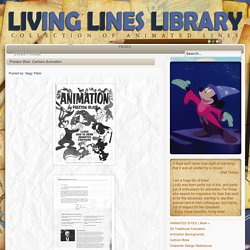
Share to TwitterShare to FacebookShare to Pinterest Címkék: books 0 Comments: Post a Comment A bejegyzésre mutató linkek Create a Link Subscribe to: Post Comments (Atom) View my complete profileContact for help in relation to any repairs or additions is here. & Thank you for your help! 57,794 Pageviews Oct. 28th - Nov. 28th Powered by Blogger. ©2010 - Living Lines Library | Template: Abu Farhan. Janel Drewis Animation: Walking in a Straight Line is Harder Than You Think. Well hello!
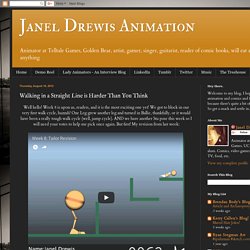
Week 8 is upon us, readers, and it is the most exciting one yet! We got to block in our very first walk cycle, huzzah! One Leg grew another leg and turned in Ballie, thankfully, or it would have been a really tough walk cycle (well, jump cycle). AND we have another Stu pose this week so I will need your votes to help me pick once again. But first! ArticleWells. Masters of Animation - Dramaturgy in "Hedgehog in the Fog" Wednesday, 9 December | 14:30 | stattkino | Estimated Duration: 80 minutes Speaker: Yuri Norstein What constitutes, in fact, creativity?
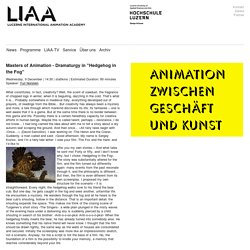
Well, the scent of sawdust, the fragrance of chopped logs in winter, when it is beguiling, dazzling in the cold. That’s what it is... Probably somewhere in medieval Italy, everything developed out of prayers, of readings from the Bible... But creativity has always been a mystery and more, a tale through which mankind discovers its life, its fantasies – one is well aware that it is a game. Offer you my own stories.» Dialogue - Specifics of Storytelling and Dramaturgy in Animation. Friday, 11 December | 14:30 | Bourbaki 2 | Estimated Duration: 80 minutes Speaker: Gil Alkabetz and Jerzy Kucia Gil Alkabetz In my lecture I mainly intend to compare animation storytelling with that of live action.
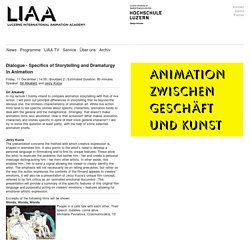
I will point out principal differences in storytelling that lie beyond the obvious one: the limitless characteristics of animation art. While live action films tend to tell specific stories about specific characters, animation tends to deal with the general and the metaphorical. The portrayal and presence of the body in animated films. Presented at the Society for Animation Studies Conference Ottawa, October 1990 by Pierre Hébert Before I begin, I would like to define the scope of this presentation.
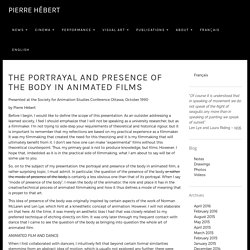
As an outsider addressing a learned society, I feel I should emphasize that I will not be speaking as a university researcher, but as a filmmaker. I’m not trying to side-step your requirements of theoretical and historical rigour, but it is important to remember that my reflections are based on my practical experience as a filmmaker. It was my filmmaking that created the need for this theorizing and it is my filmmaking that will ultimately benefit from it. Principles of Animation. The following 12 basic principles of animation were developed by the 'old men' of Walt Disney Studios, amongst them Frank Thomas and Ollie Johnston, during the 1930s.
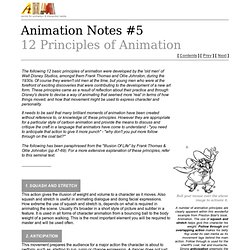
Of course they weren't old men at the time, but young men who were at the forefront of exciting discoveries that were contributing to the development of a new art form. These principles came as a result of reflection about their practice and through Disney's desire to devise a way of animating that seemed more 'real' in terms of how things moved, and how that movement might be used to express character and personality. It needs to be said that many brilliant moments of animation have been created without reference to, or knowledge of, these principles. The following has been paraphrased from the "Illusion Of Life" by Frank Thomas & Ollie Johnston (pp.47-69). Types of Animation. At the broadest sense, there are 3 types of animation: 2D, 3D and Stop Motion Any way to manipulate a sequence of images, frame by frame, is considered a Type of Animation.Animations usually fall into one of these three categories - 2D, 3D or Stopmotion.The boundaries between them are, however, blending with great speed.

For an in-depth discussion of some types and techniques of animation follow these links: 2D animation The term "2D" refers to animation that is created using two dimensional drawings.Classic hand drawn animation is the main example for this type. Computer assisted animation Flash or AfterEffects cut-out animation is also considered 2D. Flash Cut Out Animation 3D animation "3D" refers to Computer Generated Images (CGI) that create the illusion of three dimensional space with great accuracy.
Computer Generated Image of a model airplane Computer special effects also fall within this category. 1. Squash & Stretch - 12 Principles of Animation. Discover animation’s 12 principles.